The Orville's only mid-size. You should see the heavy cruisers.— Lieutenant Alara Kitan to Lysella[1]
The USS Orville, or ECV-197, is a mid-level exploratory vessel in Planetary Union service in the early 25th century, capable of speeds up to 10 light years per hour. Currently, the ship is commanded by Captain Ed Mercer and First Officer Kelly Grayson. There are 300 crewmembers on board.[2]
As an exploratory class ship, the Orville is designed for exploration and cartography of uncharted space, and can travel speeds up to 10 light years per hour. The Orville is equipped with essential military and defensive armaments, though it is not intended for combat.
Description
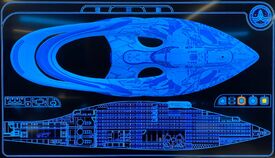
A deck grid view of the Orville from Second Officer Bortus's bridge screen.
The Orville is one of 3,000 ships in the Planetary Union. It is classified as exploratory, a spacecraft within the Union's military wing with the purpose of exploring and charting the outer reaches of the Union's home quadrant of the galaxy. The ship has a compliment of 300 crewmembers.
Schematics
As a mid-level ship, the Orville is considerably smaller than a Union heavy cruiser. Like other Union vessels, it is directed by a captain and first officer from the bridge, and complimented by a Sick Bay, Brig, engineering decks, residential quarters, a Shuttle Bay, and a Mess Hall.
Additionally, the vessel houses shuttlecraft within the Shuttle Bay with at least two shuttles: ECV-197-1, six-seat shuttle, and ECV-197-2, a back-up.
Systems
The craft's propulsion system, the quantum drive, is based on dysonium-powered quantum engines.[3] The drive configuration on the Orville provides the ship with speeds in excess of 10 light years per hour - over 87,660 times the speed of light. Space travel is navigated through spacial manifolds located in Engineering, or by traditional star charts.
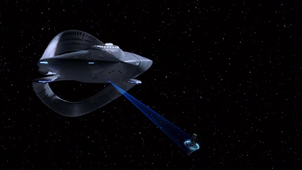
The Orville uses its tractor beam to capture the Calavon buoy.
The ship also features a tractor beam, an attenuated beam of gravity that can attract objects to the ship or can be reversed to push objects away from the ship;[n 1] as well as a beam capable of slicing a multi-kilometer long asteroid in a matter of seconds, which is colloquially called a "cutting beam."[4] The walls of the ship are made of a synthetic fiber that is an artificial sort of plant system,(citation needed) taking in carbon dioxide breathed out by the crew, and expelling oxygen. In addition to this the ship also has a water recycling system that is completely self-sustaining.
Armament
Tasked with the exploration of space, the Orville is not built for combat or warfare, though she does have respectable armaments to deal with unexpected dangers.
- Deflector Screens (deflectors): The Orville boasts a high capacity shield grid to protect itself from impacts and hostile weaponry. The ship was able to withstand a considerable beating from larger vessels, albeit not for very long before severe damage ensues. These shields can be optimized to deal with specific threats such as plasma storms, radiation, etc.
- Plasma Cannons: Pulses of high energy plasma particles. More precise than the torpedoes, able to make precision strikes against strategic points on an enemy ship, but not powerful enough to immediately penetrate the deflectors of a capital ship.
- Plasma Torpedoes: The Orville has six torpedo tubes, two are near its shuttle bay and four on its main hull. Capable of rapid fire, the Orville can also launch its entire torpedo inventory in a single volley if necessary. Torpedoes are more powerful than the energy pulse cannons, more effective against more powerful deflectors, but not as precise.
History
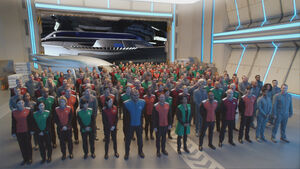
The senior and junior staff gather for first roll call under their new captain, Ed Mercer, in the episode Old Wounds.
The Orville entered service some time before 2419 under the command of an unknown series of captains. In September, 2419, Ed Mercer is appointed Captain by Admiral Halsey. Little is known of the Captain previous to Ed aside from the fact that she is a woman and was retiring from the Union. Most of her crew simply remained aboard the Orville aside from the Commander, Helmsman, and Doctor.[5]
To fill the gaps, Ed quickly recruits his friend and colleague, Lieutenant Gordon Malloy, for its pilot. Planetary Union Central transfers Doctor Claire Finn to the Orville to serve as the ship's physician.[5]
By mid-September, the Orville embarks from the Union Dockyard orbiting Earth and rendezvouses with a nearby space station to pick up Kelly Grayson for their new Commander. Kelly's transfer was kept secret from Ed until she made it aboard the Orville. In fact, it was Halsey who quietly transferred Kelly onto the Orville, who did so at Kelly's request. The friction between Ed and Kelly, who were once married, serves as a major source of conflict on the Bridge.[5]
Mission to Epsilon Science Station
Their first mission under Captain Mercer is to deliver supplies to the Epsilon Science Station on Epsilon 2. Upon arrival, station chief Doctor Aronov reveals that the request for supplies was a ruse to bring a Union vessel in order to protect the scientists from the Krill. Fortunately, the Orville's crew is able to repel a subsequent Krill attack on the laboratory as expected. During the encounter, the Orville defeats a Krill destroyer, but suffers damage to two of three propulsion rings. It subsequently undergoes repairs.
Confronting the Calivon
In October, the Orville rendezvouses with the USS Blériot, which just survived a Krill raid. Ed and Kelly take shuttle ECV-197-1 to the ship but, once "aboard," the Blériot and the commanders vanish. The Blériot was in fact a holographic projection from a Calivon buoy.
As acting captain, Alara Kitan directs helm control to rein in the buoy using a tractor beam. However, the buoy was loaded with explosives and the Orville is seriously damaged and several crewmembers hurt. Repairs are made over several weeks.[n 2]
Rescue of the Druyan
In late November, Captain Mercer and Commander Grayson lead an away team to the Dorahl bioship, which places Second Officer Bortus in the captain's chair. Bortus leads the Orville to defeat a Krill warship attacking the USS Druyan.
Capture by Pria Lavesque
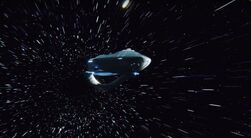
The Orville's quantum engines allow it to travel through space at faster-than-light speeds.
Several weeks later, the Orville picks up a stranded Vega Mining Consortium miner, Pria Lavesque. During a catastrophic encounter with a dark matter storm, Pria directs Science and Engineering Officer Isaac to flood the area with neutralized axion particles through the ship's weapons array, which enables the Orville's sensors to detect dark matter. Lavesque then utilizes a device on her wrist to guide the ship through the storm. The Orville is nearly destroyed but survives, and Pria gains the trust of the crew.
However, that trust was misplaced. Using the same wrist device, Lavesque overrides all control of the ship's computers and forces the Orville through a wormhole to the 29th century. Ed and the crew find themselves powerless on their own ship. The crew manages to wrest control from her by a surprise attack and takes the ship back through the wormhole to the present day.
Battle with the Kakov
At the end of the year, the Orville once again was called to battle a heavier Krill destroyer: the Kakov. The destroyer nearly destroys the Orville but Mercer directs Malloy to pilot the ship through a nearby planet's atmosphere at very high speeds. The tremendous friction damages the Orville but also creates a smokescreen that blinds the destroyer's sensor. Mercer's gambit pays off and he is able to attack the destroyer from above.
Surviving an ion storm

As a mid-level exploratory vessel, the Orville is dwarfed by larger Planetary Union ships like this heavy cruiser.
In the 25th century, ion storms are dangerous phenomena for space vessels, capable of severely damaging a ship.[n 3] The Orville has its own brush with an ion storm in March, 2420, when one causes an explosion in Engineering. The Orville receives major structural damage and loses a member of its crew, Lieutenant Harrison Payne. The damage is repaired over the next few weeks.
Crisis in two-dimensional space
Only weeks later, the Orville experiences minor structural damage and damage to the quantum drive when it passes through an unmapped spacial anomaly that turns out to be a pocket of space that exists only in two dimensions.
With the quantum drive offline for repairs, LaMarr successfully devises a plan to take the Orville through the aperture of two-dimensional space by creating a quantum bubble around the ship that preserves three dimensions within two-dimensional space. Once back through the anomaly, the crew returns the Orville to a Union station for repairs.
Personnel
| Position | Rank | Name | Species / Type | Service period | Notes | |
|---|---|---|---|---|---|---|
| Commanding Officer | Captain | N/A | N/A | Unknown-2419 | At the start of episode 1, a commanding officer is sought for the ship. | |
| Ed Mercer | Human male | 2419-Present | Joins in episode 1 | |||
| Executive Officer | Commander | N/A | N/A | Unknown-2419 | At the start of episode 1, an executive officer is sought for the ship. | |
| Kelly Grayson | Human female | 2419-Present | Joins in episode 1 | |||
| Second Officer | Lieutenant Commander | Bortus | Moclan male | Unknown-Present | ||
| Chief Security Officer | Lieutenant | Alara Kitan | Xelayan female | Unknown-Present | ||
| Chief medical officer | Lieutenant Comander | N/A |
N/A |
Unknown-2419 | ||
| Claire Finn | Human female | 2419-Present | Requests assignment to the Orville. | |||
| Chief Science Officer | Isaac | Kaylon individual | Unknown-Present | |||
| Helmsman | Lieutenant | N/A | N/A | Unkown-2419 | At episode 1, a helmsman is sought for the ship. | |
| Lieutenant | Gordon Malloy | Human male | 2419-Present | Joins in episode 1 | ||
| Navigator | Lieutenant | John LaMarr | Human male | Unknown-2420 | Promoted to Chief Engineer in New Dimensions. | |
| Unfilled | 2420-Present | |||||
| Chief Engineer | Lieutenant Commander | Steve Newton | Human male | Unknown-2420 | Accepts new position aboard a space station in New Dimensions. | |
| John LaMarr | Human male | 2420-Present | Promoted in episode 11. | |||
| Position | Rank | Person | Species / Type | Observed Service Years[n 4] | Notes | |
|---|---|---|---|---|---|---|
| Director of Operations | - | Laura Lamour | N/A | 2419 | [n 5] | |
| Technician | Ensign | Reed | Human male | 2419 | [4] | |
| Technician | Ensign | Jennings | Human male | 2419 | [4] | |
| Engineer | Lieutenant | Yaphit | Jelly | 2419-Present | Second-ranked in Engineering. | |
| Chief of Repairs | - | Kit Stolen | N/A | 2419 | [n 5] | |
| Repairs | - | Gary Rake | N/A | 2419 | [n 5] | |
| Repairs | - | Sabrina Plaice | N/A | 2419 | [n 5] | |
| Repairs | - | Tony Lattanzio | N/A | 2419 | [n 5] | |
| N/A | Lieutenant | Palovis | N/A | 2419-Present | [6] | |
| Medical Officer | - | Matt Chase | N/A | 2419 | [n 5] | |
| Medical Officer | N/A | Parley | N/A | Late 2419 or Early 2420 | [7] | |
| Assistant Medical Officer | - | Alex Maynard | N/A | 2419 | [n 5] | |
| Shuttle Bay Operator | Ensign | Brooks | Human male | 2420 | [8] | |
| Engineer | Lieutenant | Dann | N/A | Late 2419 or Early 2420-Present | [3][8] | |
| Medical Officer | Nurse | Henry Park | Human male | 2420 | [9] | |
| Medical | - | Linda Herrera | N/A | 2419 | [n 5] | |
| Engineer | Lieutenant | Harrison Payne | Human male | 2420 | Died from damage incurred by an ion storm.[9] | |
| Assistant Science Officer | - | Jack Lineweaver | N/A | 2419 | [n 5] | |
| Chief | - | Josh Pierce | N/A | 2419 | [n 5] | |
| N/A | Ensign | Parker | Human male | 2419 | [10] | |
| N/A | Ensign | Turco | Human female | 2420 | [6] |
| Position | Rank | Credited Title | Species / Type | Observed Service Years[n 6] | Notes | |
|---|---|---|---|---|---|---|
| N/A | Ensign | Crewman #1 | Human male | 2419-Present | Recurring extra.[4][11] | |
| Engineer | Ensign | Engineer #1 | Human male | 2420 | [3] | |
| N/A | Ensign | Shuttle Bay Officer #1 | Human male | 2419 | [10] |
Passengers
- Klyden, spouse of Bortus
- Topa, child of Bortus
- Ty Finn, child of Claire Finn
- Marcus Finn, child of Claire Finn
- Kanoot
- Alien Bartender, a recurring but unnamed character who serves drinks and food from the Mess Hall[4][10]
Production
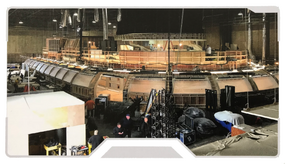
A photo of The Orville's famous two-story set from The World of the Orville.
The idea of the Orville was birthed by the show's creator Seth MacFarlane, who oversaw most creative developments of the ship. Supervising Producer and Science Consultant André Bormanis tweaked the details of the ship for scientific plausibility, and to keep the futuristic ship believable for general audiences. A group of artists led by production designer Stephen J. Lineweaver went through over 140 different concept designs of the ship before landing upon the final version.[12]
Building the set
The Orville interior was built over a period of 40 days, consuming 25,000 square feet of set space.[13]
To create an authenticate atmosphere, Fox financed the construction of a two-story studio set of the Orville. The idea came from Lineweaver, who wanted as immersive a set for the actors as possible.[14] Many in the show's production staff had worked on the 1990s science fiction show Star Trek: Deep Space Nine that utilized a two-story set as well, and they found it particularly convenient.[15] "I don't think you get an idea of how much money and how impressive the actual Orville spaceship sets are until you actually walk around on them," Jeff Bond, author of The World of the Orville, later noted in an interview. "Because they literally built the first two . . . decks of the ship; and it's all one structure, and you can walk up that spiral staircase onto the Bridge."[16]
Final approval to build a two-story set was mostly due to space and budget constraints. The Orville was to be shot in Studio 15, where the cancelled series Gang Related was filmed on a two-story build.[15] Plus, Fox could afford to construct additional sets vertically, but the high cost of additional, lateral studio space was prohibitive. "We knew we needed multiple sets, but we didn't have the floor space" executive produce Jason Clark recounted in Bond's book. "So we said, 'What if we had a two-story set? What if we built the second floor on a platform that already exists?' So that made it affordable."[13]
Designing the Orville

The first concept sketch of the Orville by Seth MacFarlane.
The Orville was designed as a self-contained world: to television audiences, it functions as the ground of most plot developments of the show; and within the universe of The Orville, as the home to a crew of 300 people. Bormanis later reflected:
This is a starship that can travel for months at a time and sustain a crew of 300 people. So we have to have a space for them that is not just necessary for survival, but is comfortable, that has the feeling of a place that you would want to live. So there's a psychological dimension: How do you keep a crew not only physically safe and alive, but how do you keep them psychologically fit?[2]
Therefore, the show's creative team designed the ship to be spacious and welcoming. Living quarters were drawn to resemble futuristic apartments. A mess hall was added as a cafeteria and social space.
The science behind living on a ship for long periods of time posed a challenge to the show's producers. Bormanis wanted a self-sustaining ecosystem integrated into the ship in order to account for the vast quantities of water, breathable air, and supplies needed to sustain a crew. Bormanis decided that the walls of the ship would be synthetic fiber, the intent being that in the future, the fibers are an artificial means to recycle air, much like plants.
Construction and filming
For the majority of scenes involving the Orville, a highly-detailed 5 ft. (1.5 m) scale model was built by Rob Legato and Glenn Derry in collaboration with Jon Favreau (who directed the pilot Old Wounds) and The Orville visual effects team. Most footage for the entire season was filmed before a blue screen in a single shoot, the same strategy used by Star Trek: The Next Generation.[17]
Space battles and other high-speed action sequences were accomplished by CGI. The physical model was imaged and transitioned to a 3D model by the previs company Halon Entertainment. Over a period of nine months, team of 10 modeled and rendered video of the ship in space battles, around wormholes or explosions.[18]
Halon developed large point-of-view video to be displayed on the set of the bridge so that actors on the bridge of the Orville could get a sense of what their characters see.[18] The technique was highly effective:
[W]hen the effects team played the full rolling pitching video on the giant screen in the Orville bridge set, the crew standing inside immediately fell over - thrown by the optical illusion of the ship rolling when the set was actually static. Basically, one's brain either causes you to lean over, and thus topple over or you suffer massive motion sickness.[17]
Visual effects company Crafty Apes designed a number of additional effects for the ship, such as hugging the donkey, a battle tactic used by Lieuteant Gordon Malloy in the episode Old Wounds.[17][19]
Production changes in Season 2
On April 19, 2018, Unit Production Manager Jason Roberts confirmed that the ship would receive an updated look for the second season.[15]
Trivia
- Captain Mercer mentions that the ship can go ten light years per hour. Since the International Astronomical Union defines the light year as the distance light travels in one Julian year (365.25 days), that translates to 87,660 times light speed.
- The items listed on the future releases section of the Fantastic Plastics Models includes a 1/1400 scale resin model kit of the Orville.[3]
- The iconic winding staircase connecting the Bridge to the ship's lower levels is a redesigned set piece from the show American Horror Story, which was filmed in the same studio.[15]
Notes
- ↑ Both uses of the tractor beam are seen in Episode 5: Pria.
- ↑ Repairs are completed before the episode concludes, which means that the repairs must take less than 21 days (because of Bortus's 21-day incubation period). Episode 2: Command Performance
- ↑ The Dorahl bioship was horribly damaged by an ion storm. Episode 4: If the Stars Should Appear
- ↑ Listed is the year a character is seen. However, recurring characters (those appearing across multiple episodes) are assumed to be static members of the Orville, and are given the year of first observation and listed until the present.
- ↑ 5.0 5.1 5.2 5.3 5.4 5.5 5.6 5.7 5.8 5.9 Crew manifest in Episode 1: Old Wounds.
- ↑ Listed is the year a character is seen. However, recurring characters (those appearing across multiple episodes) are assumed to be static members of the Orville, and are given the year of first observation and listed until the present.
References
- ↑ Majority Rule
- ↑ 2.0 2.1 "The Science Of THE ORVILLE: The Reality Of Space Travel | Season 1 | THE ORVILLE". The Orville Official YouTube. Sept. 25, 2017.
- ↑ 3.0 3.1 3.2 3.3 Episode Eleven: New Dimensions.
- ↑ 4.0 4.1 4.2 4.3 4.4 Episode Three: About a Girl.
- ↑ 5.0 5.1 5.2 Episode 1: Old Wounds
- ↑ 6.0 6.1 Episode Twelve: Mad Idolatry.
- ↑ Episode Eight: Into the Fold.
- ↑ 8.0 8.1 Episode Nine: Cupid's Dagger.
- ↑ 9.0 9.1 Episode Ten: Firestorm.
- ↑ 10.0 10.1 10.2 Episode Two: Command Performance.
- ↑ Episode Four: If the Stars Should Appear.
- ↑ Bond, Jeff. The World of the Orville. Titan Books. 2018. Pg. 11.
- ↑ 13.0 13.1 Bond, Jeff. The World of the Orville. Titan Books. 2018. Pg. 14.
- ↑ Grobar, Matt. "How ‘The Orville’s Production Designer Created The Two-Story Spaceship For “Aspirational” Series – Production Value Video Series". Deadline. April 26, 2018.
- ↑ 15.0 15.1 15.2 15.3 "The Orville Fan Podcast w/ Jason Roberts (The Orville Unit Production Manager)". Planetary Union Network. April 19, 2018.
- ↑ "The Orville Fan Podcast w/ Jeff Bond (15)". Planetary Union Podcast. Jan. 22, 2018.
- ↑ 17.0 17.1 17.2 Seymore, Mike. "Orville, a new Seth MacFarlane enterprise." fxguide. Sept. 14, 2017.
- ↑ 18.0 18.1 "The Orville". Halon Entertainment. Online. Last accessed Dec. 27, 2017.
- ↑ "The Orville (season 1)". Crafty Apes. Online. Last accessed Dec. 27, 2017.
